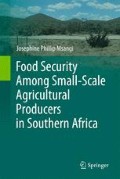Abstract
Products from land holdings of small-scale producers in Southern Africa’s dry lands are many and varied. The dry lands are known for their richness of tree species with edible fruits which contribute to food security and income generation which is sometimes higher than that from animal husbandry or arable agriculture. The inhabitants of the dry lands in Southern Africa have a rich heritage of ably managing and living harmoniously with their environment utilizing resources wisely stretching these from years of abundance into lean years. Introduced ‘development’ undertakings have greatly undermined these earlier coping mechanisms such that livelihoods and environmental health of some parts have been undermined. Loss of biodiversity occasioned by small-scale producers’ practices including bush and forest clearing to increase production required to meet developmental goals and targets is widespread. Meanwhile, small-scale producers struggle to meet their subsistence needs as well as produce for the world market economy (e.g. tobacco, fruits and cut flowers). Climate change being experienced by the rest of Africa is also affecting Southern Africa where it has caused an increase in the frequency and intensity of extreme events as well as gradual changes in the rainfall and temperature patterns. Recent interventions that borrow from the traditional coping strategies include indigenous tree domestication to increase sustainability of fruit and other tree based products.
Access this chapter
Tax calculation will be finalised at checkout
Purchases are for personal use only
References
Akinnifesi FK et al (2006) Towards the development of Miombo fruit trees as commercial tree crops in Southern Africa. Forests Trees Livelihoods 16: 103–121. AB Academic Publishers, Great Britain. http://www.icuc.iwmi.or/files/news/akinnifesi.pdf
Balick MJ, Cox PA (1996) Plants, people and culture: the science of ethnobotany. Scientific America, New York
Bennett B (2005) The economic importance of indigenous plants in Namibia: a rapid assessment. Issues in agricultural marketing, discussion paper no. 22
Bosze S (2000) Medicinal plants in rainforest: effects on biodiversity and indigenous peoples. Tropical Ecosystems of Costa Rica
Campbell B, Brigham T (1993) Paper prepared for the FAO expert consultation on non-wood forest products (Anglophone Africa)
Chingwaru W, Majinda RT, Yeboah SO, Jackson JC, Kapewangolo PT, Kandawa-Schulz M, Cencic A (2011) Tylosema esculentum (Marama) tuber and bean extracts. Evid Based Complement Altern Med, 11pp, Article ID 284795. http://dx.doi.org/10.1155/2011/284795
Christian I (1999) Exploratory case studies on socio- economic benefits derived from trees in North Central Namibia farming systems. PhD dissertation. University of Joensuu, Finland
Hargreaves BJ, Turner Q (2002) Uses and misuses of Hoodia. Asklepios 86:11–16
Henschel J, Dausab R, Moser P, Pallet J (eds) (2004) !Nara fruits for development of the !Khuiseb Topnaar, Namibia. Scientific Society Windhoek, Windhoek
Inglis JT (ed) (1993) Traditional ecological knowledge: concepts and cases. International Programme on Traditional Ecological knowledge and International Research Centre, Ottawa
Kolberg HH (2003). Conservation and evaluation of genetic resources of indigenous leafy vegetables. In: Proceedings of the 2nd national indigenous fruit workshop, 8–9 May 2003, Tsumeb
Leakey RRB et al (2005) Agroforestry tree products (AFTPs): targeting poverty reduction and enhanced livelihoods. Int J Agric Sust 3(1):1–23
Lusepani-Kamwi E (2003) Domestication and genetic improvement of some selected indigenous fruit frees. In: Proceedings of the 2nd national indigenous fruit workshop, 8–9 May 2003, Tsumeb
Lwasa S, Wahab B, Mugagga F, Simon D, Fragkias M (2013) The role of urban and peri-urban agriculture in enhancing food security and climate change resilience in East and West African cities. Final project report for 2013 START grants for global change in Africa. START 2013
Msangi JP (2008) Alleviation of risks and vulnerability facing isolated communities through conservation and management of bio-diversity: the lower Kuiseb river basin, Namibia. In: Watkins MM (ed) World poverty issues. Nova Science Publishers, New York
National Research Council (2008) Gingerbread plums. In: Lost crops of Africa: volume III: fruits. National Academies Press, Washington, DC
Shackleton CM, Clarke JM (2007) Research management of Miombo Woodlands. Paper prepared for the World Bank. Melrose Arch, Johannesburg, South Africa
Takundwa M, Chimwamurombe PM, Cullis CA (2012) A chromosome count in marama bean (Tylosema esculentum) by Feulgen Staining using garden pea (Pisum sativum L.) as a standard. Res J Biol 2(6):168–196
UN (1992) Convention on biological diversity, Rio-de Janeiro
Van Wyk BE, Gericke N (2000) People’s plants. A guide to useful plants of Southern Africa. Briza Publications, Pretoria
Van Wyk B-E, Van Oudtshoorn B, Gericke N (1997) Medicinal plants of South Africa. Briza Publications, Pretoria
Author information
Authors and Affiliations
Rights and permissions
Copyright information
© 2014 Springer International Publishing Switzerland
About this chapter
Cite this chapter
Msangi, J.P. (2014). Indigenous Plant Resources and Food Security Among Small-Scale Agricultural Producers: Southern Africa. In: Food Security Among Small-Scale Agricultural Producers in Southern Africa. Springer, Cham. https://doi.org/10.1007/978-3-319-09495-3_4
Download citation
DOI: https://doi.org/10.1007/978-3-319-09495-3_4
Published:
Publisher Name: Springer, Cham
Print ISBN: 978-3-319-09494-6
Online ISBN: 978-3-319-09495-3
eBook Packages: Biomedical and Life SciencesBiomedical and Life Sciences (R0)

